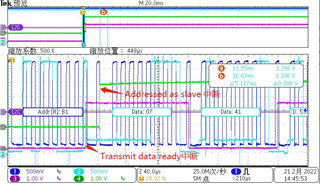{
// Initialize I2C-A:
EALLOW;
SysCtrlRegs.PCLKCR0.bit.I2CAENCLK = 1; // I2C
GpioCtrlRegs.GPBPUD.bit.GPIO32 = 0; // Enable pull-up for GPIO32 (SDAA)
GpioCtrlRegs.GPBPUD.bit.GPIO33 = 0; // Enable pull-up for GPIO33 (SCLA)
GpioCtrlRegs.GPBQSEL1.bit.GPIO32 = 3; // Asynch input GPIO32 (SDAA)
GpioCtrlRegs.GPBQSEL1.bit.GPIO33 = 3; // Asynch input GPIO33 (SCLA)
GpioCtrlRegs.GPBMUX1.bit.GPIO32 = 1; // Configure GPIO32 for SDAA operation
GpioCtrlRegs.GPBMUX1.bit.GPIO33 = 1; // Configure GPIO33 for SCLA operation
EDIS;
I2caRegs.I2CMDR.bit.IRS = 0; //I2C Reset bit.
I2caRegs.I2CMDR.bit.MST = 0; //@NOTE: 0=slave mode; 1=master mode.
I2caRegs.I2CMDR.bit.XA = 0; //@NOTE: 0=7bit address; 1=10bit address.
I2caRegs.I2CMDR.bit.BC = 0x00; //@NOTE: 0=8 bits per data byte
I2caRegs.I2CMDR.bit.NACKMOD = 0; //I2C Reset bit.
I2caRegs.I2CEMDR.bit.BCM = 0x00;
I2C_SetPMbusAddress(SLAVE_ADDRESS_INIT);
I2caRegs.I2CIER.bit.AAS = 1; //Addressed as slave interrupt enable 1h (R/W) = Interrupt request enabled
I2caRegs.I2CIER.bit.SCD = 1; //Stop condition detected interrupt enable 1h (R/W) = Interrupt request enabled
//this for non-PEC check
I2caRegs.I2CIER.bit.RRDY = 1; //receive ready
I2caRegs.I2CIER.bit.XRDY = 1; //transmit ready
I2caRegs.I2CSAR = 0x0000; // The next address.
I2caRegs.I2CPSC.bit.IPSC = 5; // Prescaler - need 7-12 Mhz on module clk (60/6 = 10MHz)
// module clock frequency = I2C input clock frequency/(IPSC + 1)
// 10MHz/(45+5 + 45 +5) = 100K
I2caRegs.I2CCLKL = 45; // NOTE: must be non zero
I2caRegs.I2CCLKH = 45; // NOTE: must be non zero
I2caRegs.I2CMDR.bit.IRS = 1; //I2C Reset bit. Take I2C out of reset
I2caRegs.I2CFFTX.all = 0x0000; // Enable FIFO mode and TXFIFO
I2caRegs.I2CFFRX.all = 0x0000; // Enable RXFIFO, clear RXFFINT,
}
initial as I2C slave device.
enable 4 type interrupt
I2caRegs.I2CIER.bit.AAS = 1; //Addressed as slave interrupt enable 1h (R/W) = Interrupt request enabled
I2caRegs.I2CIER.bit.SCD = 1; //Stop condition detected interrupt enable 1h (R/W) = Interrupt request enabled
//this for non-PEC check
I2caRegs.I2CIER.bit.RRDY = 1; //receive ready
I2caRegs.I2CIER.bit.XRDY = 1; //transmit ready
ISR code
{
Uint16 u16IntSrcReg;
// static Uint16 i = 0;
// static Uint16 j = 0;
u16IntSrcReg = (Uint16)I2caRegs.I2CISRC.bit.INTCODE;
switch(u16IntSrcReg)
{
case 0x01:
//Arbitration lost
break;
case 0x02:
//No-acknowledgment condition detected
break;
case 0x03:
//Registers ready to be accessed
break;
case 0x04:
//while(I2caRegs.I2CFFRX.bit.RXFFST < 4) {};
j= 0;
if(I2caRegs.I2CSTR.bit.SDIR == 1)
{
//
}
else//slave read data
{
RxData[i] = I2caRegs.I2CDRR;
command = RxData[0];
if(i>=6)
{
i=0;
}
else
{
i++;
if((command_type == 1)&&(command == 0x99))//command length =1
{
i=0;
}
}
}
break;
case 0x05://Transmit data ready
if(command == 0x99)
{
//while(!I2C_xrdy());
//while(I2caRegs.I2CSTR.bit.XRDY != 1) {};// 1 = Data transferred tp the core TX register after shifting data
if(j>=7)
{
I2caRegs.I2CDXR = 0xFF;
}
else
{
I2caRegs.I2CDXR = Array[j];
}
j++;
}
else
{
I2caRegs.I2CDXR = 0xFF;
}
break;
case 0x06:
//Stop condition detected
break;
case 0x07:
//Addressed as slave
if(I2caRegs.I2CSTR.bit.SDIR == 1) //means address read
{
//address read
I2C_bIsSlaveAddressRead();
}
else
{
//I2caRegs.I2CIER.bit.XRDY = 0;//address write
//I2caRegs.I2CMDR.bit.TRX = 0;
I2C_bIsSlaveAddressWrite();
//i=0;
}
break;
default:
//error happen
break;
}
PieCtrlRegs.PIEACK.all = PIEACK_GROUP8; //release other interrupt
}
when I add test pin in the code, get below waveform.
channel 3: toggle when XRDY happen channel4: toggle when AAS happen.
question: why AAS happen before than XRDY? if I need to exchange it, how to config the I2C module? thanks!



